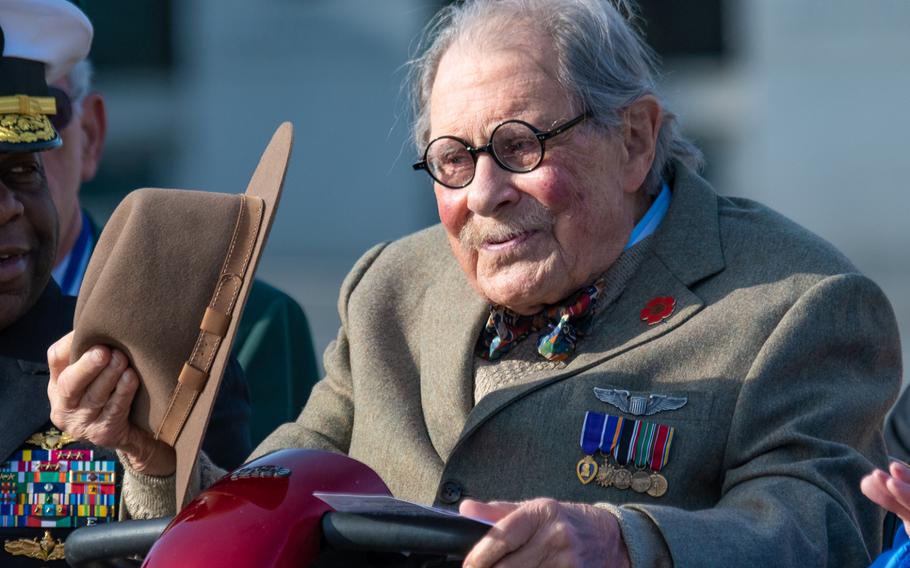
Ewing Miller served in the US Army Air Forces from 1942 to 1945 as a B-24 Heavy Bomber Pilot assigned to the 15th Air Force. He flew over 20 missions before his plane was downed with him the only survivor. He spent the rest of the war as a Prisoner of War. On November 11, 2019, she took part in a Veterans Day wreath laying at the World War II Memorial in Washington, D.C. (Meredith Tibbetts/Stars and Stripes)
WASHINGTON — Time may have stolen their youth, but as their names were announced and their battle history told, they stood tall after rising from their chairs on their own accord.
For their Veterans Day ceremony this year, the Friends of the National World War II Memorial decided to include a Parade of Heroes, where each World War II veteran was singled out and their service descriptions read to the audience.
Before and after Monday's wreath-laying ceremony, the veterans were surrounded by friends, family members, well-wishers, tourists and reporters. Everyone wanted a chance to thank them; they were the celebrities of the hour. A few were asked for autographs, another veteran posed with a calendar that had his image in it.
“At the Battle of the Bulge I almost froze. I couldn’t put shoes on for a week," World War II veteran Steve Bukovac remembered. "We have these black boots called galoshes. A lot of guys with gangrene and they had to get their legs amputated. I’m fortunate to come back with my limbs.”
Bukovac served in the Army, and saw action in the Ardennes, Rhineland, Central Europe and the Battle of the Bulge.
“I got drafted in July ‘44 … In November, they took us overseas,” Bukovac said. In France, they didn’t have a place to dock, "so we got down in a chute into a barge.”
He joined the Battle of the Bulge just before his birthday, December 10, two weeks before Christmas.
Veteran Urias Hughes graduated from high school in 1944 as the youngest student in the class, and had to wait until he was drafted because his parents wouldn’t sign him up.
“They started talking about invading Japan. So we trained for Japan,” Hughes said. The war ended as he was headed to the Pacific, and he served as part of the occupation force in Japan. Hughes recalled that there were so many ships in the harbor of Okinawa preparing for the invasion, that "you could have walked to Japan" from boat to boat.
“We probably were at Hiroshima not too many months after the bomb was dropped,” Hughes said.
“It was real good, easy duty, because I wound up going to work at the general’s house" and driving the two-star’s jeep. “We always called it dog robbing. I mean anything he wanted I had to do.”
Army nurse Elizabeth Lewis saw action in Europe and the Pacific theaters. Assigned to the Army Hospital Ship Emily Weder as a surgical nurse, she treated the wounded from North Africa, Italy and the invasion of Southern France, and continued to care for servicemembers in New Guinea and the Philippines.
“I went in on the seventh France invasion." Lewis said. "I was there about two months, then they sent us back and then we went directly to the Pacific. And there we were all over the Pacific. Mainly we went back to Clark Air Force Base so the boys could be flown back home."
“The Pacific was the worst," she said. "The climate and the danger. We were stopped by the (Japanese) subs more than once. They did sink two hospital ships.
"I just wish we could have brought them all back. We did what we could.”
At the end of the ceremony, Hughes embraced fellow WWII veteran Harry Miller.
“Just met today," Lewis said. "That’s the great thing about our generation — You meet one and you know them forever.”
tibbetts.meredith@stripes.com Twitter: @mjtibbs